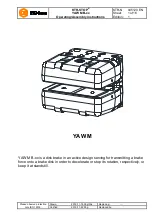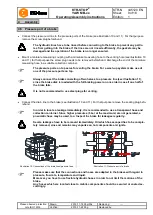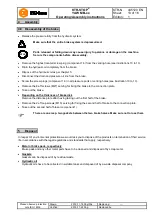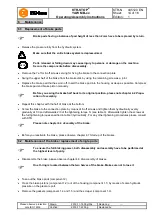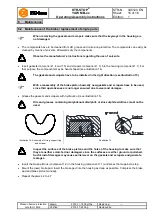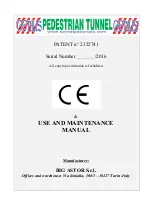
KTR-STOP
®
YAW M B-xx
Operating/Assembly instructions
KTR-N
Sheet:
Edition:
445120 EN
14 of 16
1
Please observe protection
note ISO 16016.
Drawn:
2019-11-18 Shg/Wie
Replacing:
---
Verified:
2019-11-22 Shg
Replaced by:
Brake pads having a balance of pad height of less than 2 mm have to be replaced by return.
•
Release the pressure fully from the hydraulic system.
!
Make sure that the entire brake system is depressurized.
STOP
Parts released or falling down may cause injury to persons or damage on the machine.
Secure the components before disassembly.
•
Remove the 7-off or 8-off screws serving for fixing the brake to the connection plate.
•
Swing the upper half of the brake from the brake disk by using the remaining screw as a joint.
•
Replace the brake pad that has worn off. Insert the brake pad into the housing as deep as possible. Compress
the brake pad and brake piston manually.
Before you swing the brake half back to its original position, please note chapter 4.2 Prepa-
ration of assembly.
•
Repeat this chapter with the half of brake at the bottom.
•
Screw the brake to the connection plate by means of 8-off screws and tighten them hydraulically evenly
gradually at 1/3 and afterwards 2/3 of the tightening torque T
A
(see table 3). Afterwards tighten the screws at
the full tightening torques specified in table 3 hydraulically. For any other tightening procedures please consult
with KTR.
Please note chapter 4.4 Assembly of the brake.
•
Before you reactivate the brake, please observe chapter 4.7
Start-up of the brakes
.
To ensure the full braking power, both disassembly and assembly have to be performed at
the highest level of purity.
•
Disassemble the brake, please observe chapter 4.9
Disassembly of brakes
.
One O-ring is located between the two halves of the brake. Make sure not to lose it.
•
Take out the brake pads (component 2).
•
Press the brake pistons (component 1.2) out of the housing (component 1.1) by means of some hydraulic
pressure on the pressure port.
•
Remove the gaskets (component 1.4 and 1.5) and the scraper (component 1.3).
6
Maintenance
6.1 Replacement of brake pads
6.2 Maintenance of the brake / replacement of single parts

